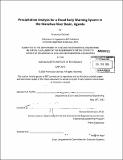| dc.contributor.advisor | Richard Schuhmann. | en_US |
| dc.contributor.author | Cecinati, Francesca | en_US |
| dc.contributor.other | Massachusetts Institute of Technology. Department of Civil and Environmental Engineering. | en_US |
| dc.coverage.spatial | f-ug--- | en_US |
| dc.date.accessioned | 2013-12-06T20:44:42Z | |
| dc.date.available | 2013-12-06T20:44:42Z | |
| dc.date.copyright | 2013 | en_US |
| dc.date.issued | 2013 | en_US |
| dc.identifier.uri | http://hdl.handle.net/1721.1/82807 | |
| dc.description | Thesis (M. Eng.)--Massachusetts Institute of Technology, Dept. of Civil and Environmental Engineering, 2013. | en_US |
| dc.description | Cataloged from PDF version of thesis. | en_US |
| dc.description | Includes bibliographical references (p. 61-64). | en_US |
| dc.description.abstract | The communities living in the Manafwa River Basin experience frequent floods threatening their lives and property. Climate change and anthropogenic perturbations to the natural environment increase flooding frequency. This study was performed in conjunction with the Uganda Red Cross Society (URCS) to design a hydrological model for a precipitation based flood forecasting system for the Manafwa River Basin. The hydrological model relates precipitation with flood risk and flood extent. The main input for the model is the basin precipitation. The rainfall data from satellite precipitation estimates produced by the Tropical Rainfall Measurement Mission (TRMM) were used to run the model and observed Manafwa River levels were used to calibrate the model. A calibrated hydrological model is capable of estimating the flood risk given the precipitation and can be used with short term forecasts to trigger an early warning system. Furthermore, the rainfall characteristics and the main climate patterns influencing the basin precipitation were analyzed. Although in recent years the flood magnitude and frequency increased, the average precipitation decreased. Rainfall events are becoming less frequent but more intense. A more intense precipitation rate on a dry soil, with low hydraulic conductivity, generates a higher runoff and can contribute to the increase of the flood events, especially at the beginning of the wet seasons. The influence of the El Niño Southern Oscillation on the precipitation was investigated, but no correlation was found at a local scale. | en_US |
| dc.description.statementofresponsibility | by Francesca Cecinati. | en_US |
| dc.format.extent | 64 p. | en_US |
| dc.language.iso | eng | en_US |
| dc.publisher | Massachusetts Institute of Technology | en_US |
| dc.rights | M.I.T. theses are protected by
copyright. They may be viewed from this source for any purpose, but
reproduction or distribution in any format is prohibited without written
permission. See provided URL for inquiries about permission. | en_US |
| dc.rights.uri | http://dspace.mit.edu/handle/1721.1/7582 | en_US |
| dc.subject | Civil and Environmental Engineering. | en_US |
| dc.title | Precipitation analysis for a flood early warning system in the Manafwa River Basin, Uganda | en_US |
| dc.type | Thesis | en_US |
| dc.description.degree | M.Eng. | en_US |
| dc.contributor.department | Massachusetts Institute of Technology. Department of Civil and Environmental Engineering | |
| dc.identifier.oclc | 862118209 | en_US |
